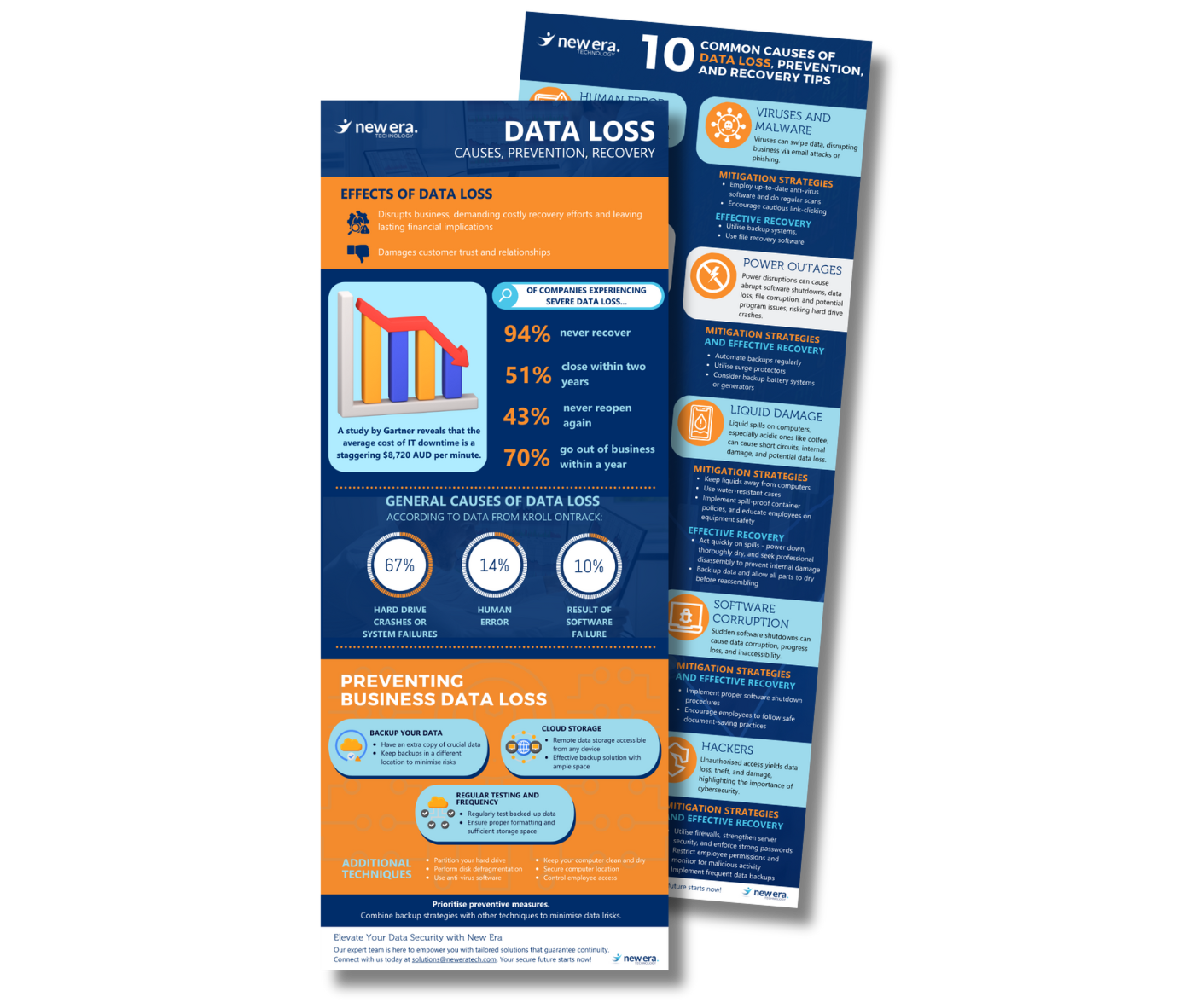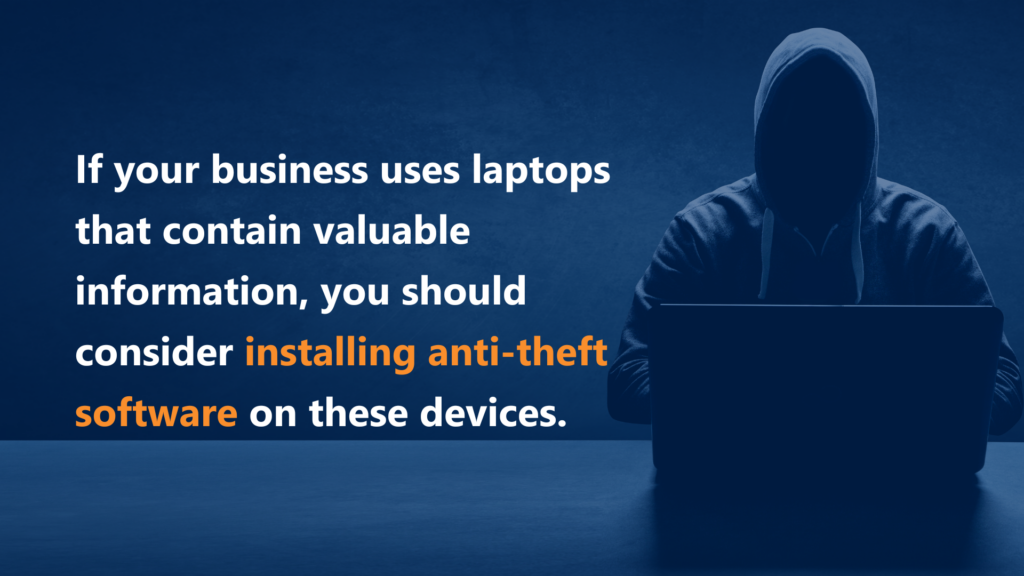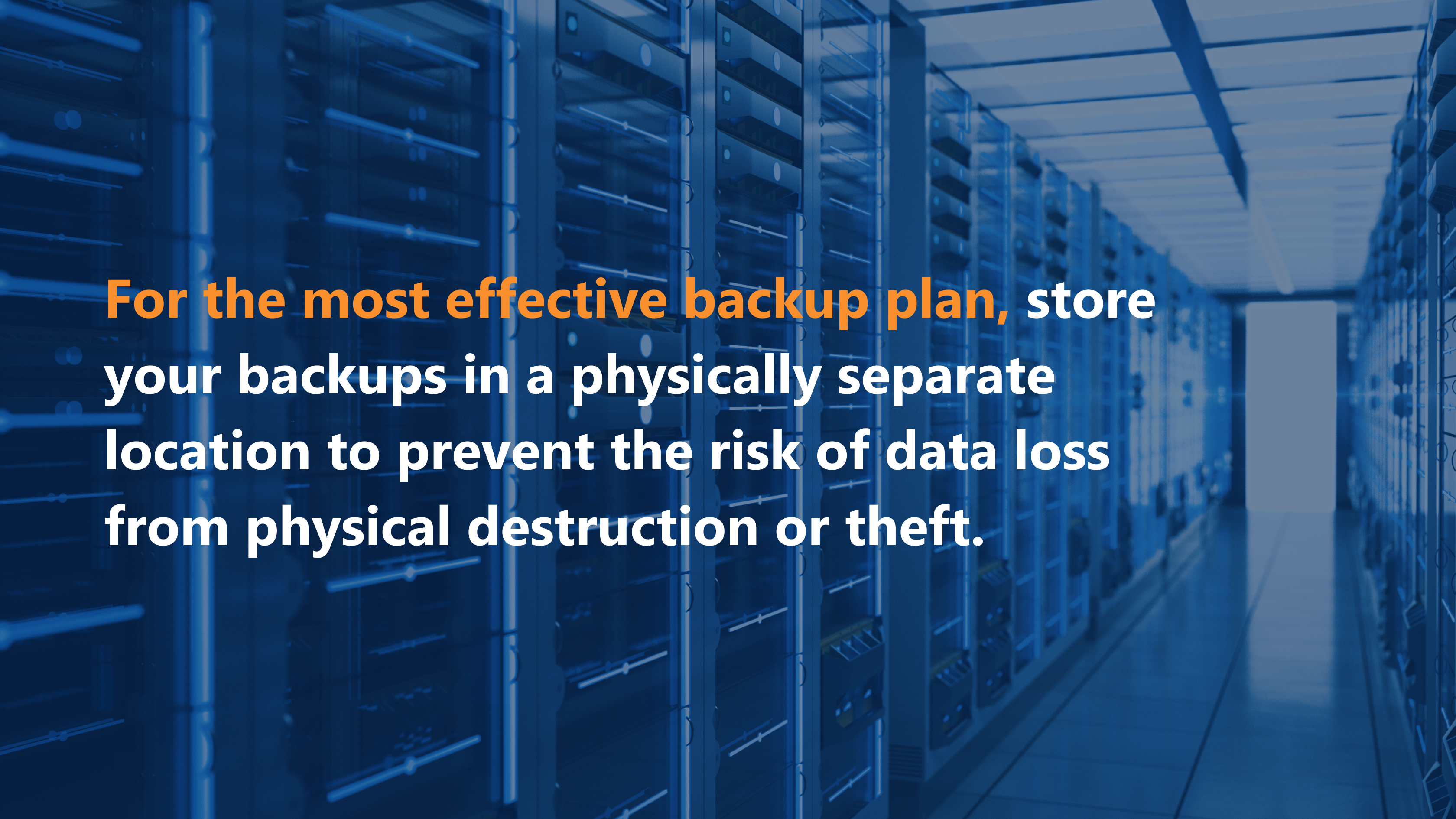
Download Infographics | 10 Common Causes of Data Loss, Prevention, and Data Recovery Tips and Tricks
Data loss is a serious problem
for businesses of all sizes.
Losing files means losing time and money to restore or recover information that is essential to your business. Data loss occurs when data is accidentally deleted or something causes data to become corrupted. Viruses, physical damage, or formatting errors can render data unreadable by both humans and software. Losing files and documents often has a lasting impact on your company’s financial health.
Some lost data is recoverable, but this process often requires the assistance of IT professionals and costs time and resources your business could be using elsewhere. In other instances, lost files and information cannot be recovered, making data loss prevention even more essential. You can minimise your business’s potential for data loss by understanding its causes. Read on for the ten most common causes of data loss, how to prevent them, and tricks for recovering data if the loss does occur.
Effects of Data Loss on Businesses
Data loss is a major inconvenience that disrupts the day-to-day function of any information-based business. When important files and documents are lost, your business must spend time and resources recreating or recovering these files to fill the gaps left by loss. While you may be able to locate hard copies of information, these may not be as up-to-date as the lost digital copies. Data loss caused by corruption or viruses poses particular problems as the extent of data loss caused can sometimes be difficult to determine. It can be costly for your business to weed out and repair damaged files.
Data loss also sets back productivity timelines and can cause you to lose customers if it is accompanied by security breaches. When sensitive data is stolen or compromised, your company must disclose this to clients, causing you to lose their trust and respect. Even if your company can recover from the data loss, you will need to spend time rebuilding client relationships.

The inconvenience of data loss can have even bigger implications for your business when a large amount of data is lost:
94% of companies that experience severe data loss do not recover
51% of these companies close within two years of the data loss
43% of these companies do not reopen again
70% of small businesses shut down within a year of a large data loss incident
Leaving data unprotected is an expensive risk to take — According to a study by Gartner, the average cost of IT downtime is $8,720 AUD (or $5,600 USD) per minute.
Data loss can be caused by many different factors, and each poses a unique problem for data recovery. Hard drive crashes account for the highest percentage of data loss, but human errors and issues with software follow closely behind. According to data from Kroll Ontrack:
67% of data loss is caused by hard drive crashes or system failure
14% of data loss is caused by human error
10% of data loss is a result of software failure
10 Common Causes of Data Loss
Awareness of the types of data loss and the risks associated with losing data is essential for preventing data loss that can be a major cost to your business.
1. Human Error
Humans are not infallible — we all make mistakes and sometimes they’re big ones. For businesses, these mistakes can result in the unintentional deletion of data files or sections of text. Without realising it, employees can overwrite important files or delete information that is essential to your business. Human error can also play a role in many other main causes of data loss, including hard drive damage, liquid spills, software corruption, and hard drive formatting.
- Prevent Human Error: Provide thorough training to employees about data processing and backup systems, clarifying whether backups are automatic or manual.
- Software Solutions: Employ automation to reduce human interaction with data, optimise workflows to minimise errors, and utilise backup systems to preserve data states.
- Data Recovery: Utilise Recycle Bin for simple data recovery, access previous document versions when possible, and employ file recovery software to scan and restore lost data.
2. Viruses and Malware
Most people think of viruses when you ask them what causes data losses. For businesses, viruses can steal and delete swaths of data or bring business operations to a crawl, destroying company functionality. A computer often gets a virus from an email-based attack or through phishing that tempts an employee to click on a corrupted link. This link then allows the virus or malware to enter the computer system to damage or steal files.
- Malware Defense: Use updated anti-virus software, run regular scans, and maintain system backups to safeguard against malware and ensure data recovery.
- Data Recovery: Regular backups are crucial for retrieving lost data caused by malware; backup copies are often the only way to restore compromised information.
3. Hard Drive Damage
Most data losses result from hard drive failures, the weakest components in computers. About 140,000 hard drives crash each week, 60% due to mechanical problems and 40% due to human errors like mishandling or overheating, typically caused by overuse or a build-up of dust in the computer.
However, as with any machine, a hard drive will wear out over time and will eventually stop working. The following are some signs to watch out for that indicate a hard drive may be failing: i) the hard drive frequently crashes; ii) the computer is unusually hot; iii) the hard drive experiences issues while booting up; iv) the processing speeds are continually slow; v) the computer freezes frequently; vi) the computer makes clicking or grinding noises; and/or vii) the files will not open or become corrupted randomly.
- Preventing Hard Drive Issues: Handle devices carefully, avoid dust exposure, and back up data regularly to prevent hard drive malfunctions and data loss.
- SSD Advantages: SSDs (solid state drives) are more durable and less likely to malfunction than HDDs (hard disk drives), but they can be costlier. Data protection measures are crucial for both types of drives.
- Data Recovery from Hard Drive Damage: Attempt data recovery by connecting the damaged hard drive to another computer or using recovery software. For severe damage, seek professional assistance for data recovery from crashed hard drives.
4. Power Outages
Power outages can interrupt business operations substantially, shutting software systems down without warning. Not only can this result in the loss of unsaved data, but it can also cause existing files to be corrupted due to improper shutdown procedures. Sometimes, a poorly timed power outage may render entire programs non-functional. If a computer shuts down while it is writing to the hard drive system, it may never start up again.
Even if you do not lose data during a power outage, improper shutdowns can have lasting impacts on computer hard drives. If power outages or surges happen frequently, the lifespan of a hard drive will be greatly reduced and it will be more likely to crash.
- Data Protection Measures: Ensure regular automatic backups to safeguard against power-related issues, including power outages. Utilise surge protectors and backup battery systems/generators to prevent damage and enable data backup during power disruptions.
5. Computer or Laptop Theft
In the modern workplace, more and more people are becoming mobile. This often means they are working from laptops or smartphones rather than PCs. Laptop theft is a serious risk and can happen anywhere if a laptop is left unattended. According to a study by Kensington:
25% of IT theft occurs in cars or other transportation vehicles
23% takes place in the office
15% happens in airports or hotels
12% occurs in restaurants
On top of losing data, laptop theft also poses the threat of a data breach. In fact, stolen or lost devices accounted for over 40% of all data breaches from 2005 to 2015.

Portable Device Security: Enable remote data wiping for sensitive information on portable devices. Back up crucial laptop data to a secure location.
Office Computer Protection: Store office computers in locked rooms accessible only to authorised personnel. Implement secure lock-up procedures after business hours to prevent theft.
Laptop Anti-Theft Measures: Install anti-theft software on valuable laptops for tracking stolen devices, potential law enforcement assistance, and remote data wiping capability.
6. Liquid Damage
Spilling coffee or water on your laptop or computer can cause a short circuit, making it difficult to recover your computer, let alone the data stored inside. If your computer somehow gets completely submerged, the situation is even more serious. Sometimes a computer may seem to work fine after a spill, but the internal damage can have lasting effects that cause the computer to short-circuit in the future. Acidic drinks, like coffee, pose a particular risk as they can corrode the inside of a computer if a spill is not cleaned up properly.
Liquid Damage Prevention: Avoid liquids near computers, use water-resistant cases for laptops, and implement spill-proof container policies or designated beverage areas.
Quick Spill Response: Immediately power off and dry a spilled-on computer, and dismantle it with professional assistance to check internal components for moisture. Allow full drying before reassembly. Swift action helps minimise damage, but back up data anyway for potential future issues.
Data Protection: Ensure data backup in case of future issues, even if a quick spill response has minimised damage.
7. Disasters

From tornadoes to fires, disasters can happen when you least expect them and can have devastating impacts on your business. They can destroy your computer, your data, and even your business entirely. Natural disasters can cause irreparable damage to a business if data is not backed up:
93% of companies experiencing data center loss for over 10 days due to disasters filed for bankruptcy within a year
50% of companies that lost data management due to a disaster filed for bankruptcy immediately
30% of businesses that experience a severe fire go out of business within a year
70% of businesses that experience a severe fire go out of business within 5 years
Because natural disasters can destroy a company’s technology entirely, it is often not possible to recover data lost due to a disaster.
Disaster Preparedness: Back up data weekly and store it securely to minimise the impact of disasters.
Remote Data Backup: Natural disasters may lead to irretrievable data loss, emphasising the importance of remote, secure data backup.
8. Software Corruption
Unexpected or improper software shutdowns may seem innocent on the surface but can cause serious issues for your data. Improper shutdowns can corrupt your data or delete your progress, wasting time and losing valuable data. When software is corrupted it may not be able to run again, meaning you cannot access data stored in that software.
- Mitigate Software Corruption: Establish proper shutdown procedures after use, power down carefully, and avoid interrupting software processes with diagnostic tools.
- Employee Practices: Encourage consistent saving during editing, safe shutdown procedures, and adherence to these practices to minimise the risk of business data loss from software corruption.
9. Hard Drive Formatting
Accidental formatting of your hard drive can cause you to lose data instantly. Employees can accidentally format a hard drive if they misunderstand system prompts or error messages. Reformatting can also occur during system updates and result in data loss.
- Data Recovery after Formatting: Ease panic of accidental hard drive reformatting by using data recovery software to retrieve lost files and documents.
10. Hackers and Insiders
In recent years, hacking and data breaches have become a much more common problem, making good cybersecurity measures essential. Unauthorised guests in your network can cause serious damage to your data, deleting and stealing any data they wish. They can even damage entire network processes if they have sufficient access to your system. The unfortunate truth is that data is sometimes stolen or compromised by employees themselves or other insiders.
Cybersecurity Measures: Prevent data losses by employing firewalls, secure servers, and strong passwords to deter hackers.
Employee Permissions: Establish varying access levels to thwart insider data breaches and monitor for suspicious activity.
Data Protection: Recognise that recovery from data stolen by hackers or insiders can be challenging. Prioritise prevention through cybersecurity actions and regular data backups.
How to Prevent Data Loss

The most effective way to prevent business data loss is to back up all of your files and documents. Backing up data means that you have at least one additional copy of all important data. For the most effective backup plan, store your backups in a physically separate location to prevent the risk of data loss from physical destruction or theft.
Cloud storage is also an effective means of backing up data as it stores data remotely and is easily accessed from any device through the Internet. Cloud storage often has more space than a traditional server and does not pose risks of crashing.
According to Small Business Trends, 78% of small businesses are projected to use cloud storage to back up their data by 2020. While cloud storage eliminates the possibility of theft or physical damage, data can still be lost in the cloud if it is accidentally deleted, overwritten, or stolen by hackers.
No matter how you choose to back up your data, it is essential to make sure your data is backed up properly before a catastrophic data loss occurs. No one wants to realise after a data loss that files did not write correctly to the backup server and are corrupted. Perform periodic tests of backed-up data to ensure your documents are properly formatted and there is enough space to store your files in your backup destination. Backups should be performed frequently so that minimal data is lost should your main system for data storage go down.
In addition to the ever-crucial backup, here are some other techniques to avoid business data loss:
- Partition your hard drive: Partitioning a hard drive means creating separate programs and data zones. This means that if the program portion of a hard drive crashes, you may be able to recover the data because it is stored in a separate location.
- Perform disk defragmentation: The process of saving and deleting files naturally creates gaps on the hard drive that other files are then filled into. When data is split into segments for storage it takes longer for the computer to access the data and also makes file corruption more likely if the hard drive crashes. Defragmentation arranges files more contiguously to lower the risk of data loss and speed up computer processing time.
- Use anti-virus software: Anti-virus software is essential to prevent viruses and malware from infecting your computer. Be sure to keep anti-virus software updated so it runs properly and effectively.
- Keep your computer clean and dry: Dust or moisture collecting in a computer can cause the hard drive to crash or the computer to overheat. Store all computers and laptops in dry, ventilated areas.
- Keep computers in a safe location: Computers should be kept stationary and in a location where they are not likely to be jostled or damaged. Keeping your computers out of the way will also reduce the risk of theft.
- Control employee access: All employees working with company data should be properly trained about confidentiality or how data can be shared. It is in the best interest of your company to control who can access different levels of data to protect from accidental or intentional data loss.
Contact New Era Technology to Learn More
Need help implementing systems to protect your data against losses and ensure your business continuity?
New Era can help with experienced technicians who can design and implement the solutions you need. Our innovative services have helped more than two thousand companies improve their systems and we can do the same for your business.
Start your journey today — contact New Era today to learn more at solutions@neweratech.com.

 Canada
Canada New Zealand
New Zealand UAE
UAE United Kingdom
United Kingdom United States
United States




